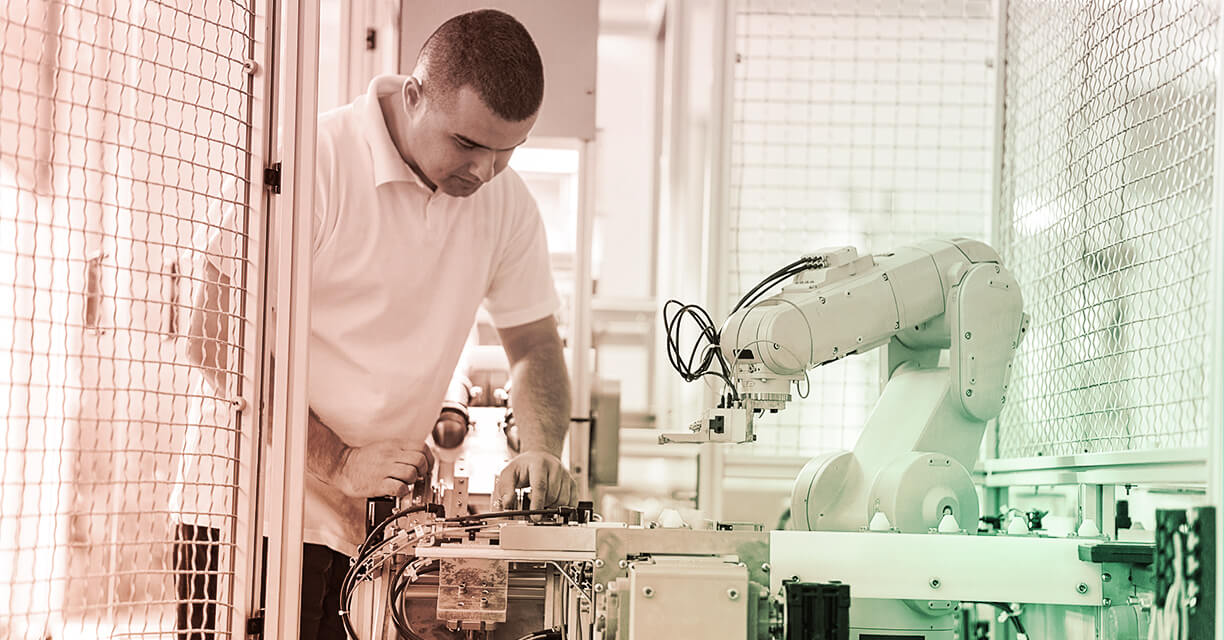
Man Meets Machine
Baird Capital's Industrial Solutions Team Explores the Advantages of Collaborative Robotics



AUTHORS
JAMES BENFIELD
PARTNERBAIRD CAPITAL
ANDREW DYER
INVESTMENT DIRECTORBAIRD CAPITAL
Collaborative Robotics ("Cobots") is a new generation of lightweight, flexible and mobile robots capable of safely working alongside workers within production and distribution environments. The transition to more modular and flexible manufacturing environments that meet the increasing demand for customization, combined with advances in low-cost technology, is helping to usher in this new era of robotics.
Generally speaking, collaborative robots are mobile systems capable of sharing a workspace, collaborating and cooperating (via some physical contact) with humans. Industry leaders Rethink Robotics introduced the term "collaborative" and pioneered this new class of robot with the launch of the Baxter Cobot in 2012. Since then, companies like ABB, Fanuc and Universal Industries have entered the arena with their own collaborative models.
Current technology focuses on sequential collaboration, or robots and humans working separately to complete each step of a production process. Emerging designs are capable of simultaneous collaboration, or two parties performing separate tasks in a shared workpiece at the same time. Designers are now targeting supportive collaboration, where robots and humans work simultaneously on the same task. However, this technology is a few years away from industrialization.
Typical applications of collaborative robots include pick-and-place, line loading, material handling and machine tending. Most suitable applications involve the repetitive movement of lightweight parts and take place in close proximity to humans. Collaborative robots offer many advantages over traditional industrial robots:
- They are designed to be safe around humans through force-limiting technology, pausing in response to contact or proximity sensors that detect the presence of human workers.
- Unlike the large robot systems favored by the automotive industry, they are compact, lightweight and can be moved around a factory or distribution center.
- They are comparable to smartphones or tablets in their user-friendliness and can be reconfigured for different tasks and activities.
- The focus on software versus bespoke hardware, ease of setup and programming and increased flexibility should make collaborative robots cheaper to purchase and maintain than traditional industrial robotics.
In addition to implementation, adaptability and cost benefits, collaborative robots are expected to drive productivity by combining the power and precision of robots with the creativity and problem-solving ability of humans. This refutes common concerns around automation displacing human jobs and promotes a more favorable economic outcome where robots elevate the contribution and value of the human role.
Anecdotes from electronics companies that have already adopted the technology are largely supportive of this theory. For example, a study by MIT researchers on BMW's production lines showed teams consisting of humans and machines are more productive and less idle than teams consisting of only humans or machines. At Continental's Texas manufacturing facility, the implementation of collaborative robots boosted the value-added nature of the team's activities and enhanced their technical capabilities. It also deterred the movement of operations to lower-cost locations. At Paradigm Electronics, a manufacturer of high-end speakers and AV components, the addition of collaborative robots has increased throughput by 50%.1 Other success stories include Johnson & Johnson, Harley Davidson, Trelleborg and Volkswagen.
Health benefits are an additional draw. For instance, Audi AG's recent deployment of collaborative robots as part of its PART4you initiative at its main factory in Germany is helping to reduce potential back problems among its employees by eliminating the need to reach over long distances or bend down repeatedly.
With such positive feedback from early adopters, it's easy to see why many are saying collaborative robots are here to stay. Estimates assume 80% growth per annum over four years, taking the value of the market from less than $100 million in 2015 to more than $1 billion in 2020, with volumes expected to rise from ~3,000 units to 40,000 over the same period.2
The thrust of initial demand is expected to arise from the consumer electronics industry, particularly from manufacturers engaged in small parts assembly activities. In addition, it is expected that given the lower cost and clear benefits of the technology, a large portion of the growth will be driven by small- and medium-sized manufacturing companies.
BAIRD CAPITAL'S INVESTMENT APPROACH
At Baird Capital, we are seeking investments in high-quality businesses that are benefiting from the growth in industrial automation. With our global capabilities and deep sector experience, we believe that we are well-positioned to help differentiated and growing companies in the sector, particularly those with international ambitions.
1SCM World – "Collaborative Robotics and the Evolution of the Species". Available at: scmworld.com/collaborative-robotics-evolution-species
2Robotics.org – "Collaborative Robots and Safety Hand in Hand". Available at: robotics.org/content-detail.cfm/industrial-robotics-industry-insights/collaborative-robots-and-safety-hand-in-hand/content_id/6198






